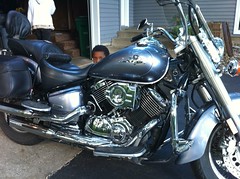Planning a Motorcycle Road Trip
Planning a Motorcycle Road Trip
As summer draws near, the call of the open road beckons you to seek out new adventures. Here are a few tips to help you plan for your next motorcycle road trip.
Packing for a motorcycle trip takes a little more thought than packing for a trip in the car. You have limited storage space and plenty of items that you might need along the way. The key is to pack as compact and lightweight as possible. If you’re not sure you’ll need an item, remember that you can always pick up an extra sweatshirt or other item along the way.
Instead of packing bulky clothing for cold weather, pack layers. The warmer it gets, the more layers you can shed, and if the weather turns colder, you can always pile on more layers. Remember to pack your rain gear and a safety and repair kit for emergencies on the road. If you plan to pick up a few souvenirs along the way, leave enough extra storage room for those as well. Don’t forget to pack a travel motorcycle cover to protect your bike on the road. A cover not only shields your bike from the elements but it also keeps it out of sight from vandals and thieves. Secure a lock through the grommets for extra protection.
When you fill your saddlebags, try to balance out the weight on each side as much as possible. Pack heavier items in the bottom for a stable base, and leave the lighter items for on top. Engine guard chaps serve a double purpose by keeping your feet warm and dry and providing extra storage space for maps, sunglasses, a water bottle, cell phone, flashlight, or other small items. Engine guard chaps, or soft lower covers, keep your feet from getting soaked in the rain or chilled in cold weather.
Perform a thorough maintenance check on your bike to make sure your trip goes as smoothly as possible. Follow the T-CLOCS method compiled by the Motorcycle Safety Foundation:
Tires and Wheels: Check for proper inflation and make sure you have enough tread left for the miles you plan to cover.
Controls: Inspect the throttle, cables, hoses, and levers.
Lights: Check the headlights, tail lights, turn signals, and brake lights.
Oil: Check fluid levels and top off or change as needed.
Chassis: Make sure your frame, suspension, belts, and fasteners are working properly.
Stands: Make sure your center and side stands are able to support the weight of your motorcycle.
As a safety measure, let someone know your travel plans and when you plan to come home from your motorcycle trip. You can still be flexible along the way. Just let that someone know if your plans change. Leave room to be spontaneous. That’s where you make the best memories.




